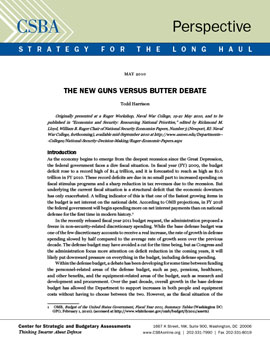
As the economy begins to emerge from the deepest recession since the Great Depression, the federal government faces a dire fiscal situation. In fiscal year (FY) 2009, the budget deficit rose to a record high of $1.4 trillion, and it is forecasted to reach as high as $1.6 trillion in FY 2010. These record deficits are due in no small part to increased spending on fiscal stimulus programs and a sharp reduction in tax revenues due to the recession. But underlying the current fiscal situation is a structural deficit that the economic downturn has only exacerbated. a telling indicator of this is that one of the fastest growing items in the budget is net interest on the national debt. According to OMB projections, in FY 2018 the federal government will begin spending more on net interest payments than on national defense for the first time in modern history.
In the recently released fiscal year 2011 budget request, the administration proposed a freeze in non-security-related discretionary spending. While the base defense budget was one of the few discretionary accounts to receive a real increase, the rate of growth in defense spending slowed by half compared to the average rate of growth seen over the previous decade. The defense budget may have avoided a cut for the time being, but as Congress and the administration focus more attention on deficit reduction in the coming years, it will likely put downward pressure on everything in the budget, including defense spending.
Within the defense budget, a debate has been developing for some time between funding the personnel-related areas of the defense budget, such as pay, pensions, healthcare, and other benefits,and the equipment-related areas of the budget, such as research and development and procurement. Over the past decade, overall growth in the base defense budget has allowed the Department to support increases in both people and equipment costs without having to choose between the two. However, as the fiscal situation of the federal government continues to deteriorate in the coming years, sustained growth in the defense budget is unlikely. When the defense budget ceases to grow above the rate of inflation,the Department will have to make difficult choices between competing priorities, such as personnel and equipment. This is the new guns versus butter debate—a choice between taking care of the people who serve or the equipment they need to fight and prevail in current and future conflicts.



























